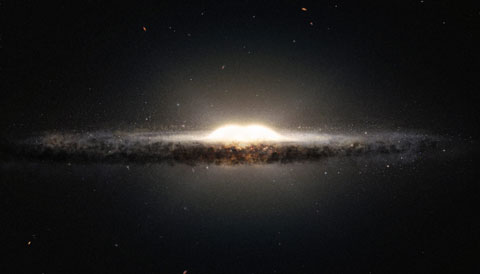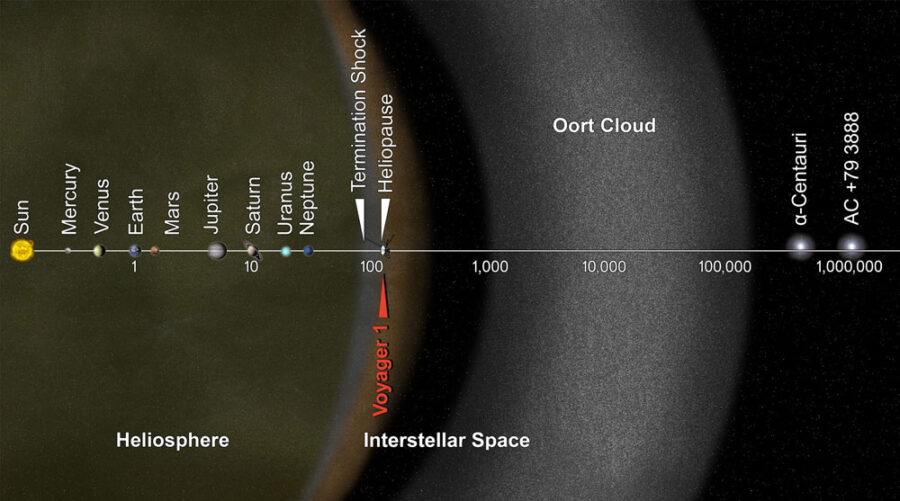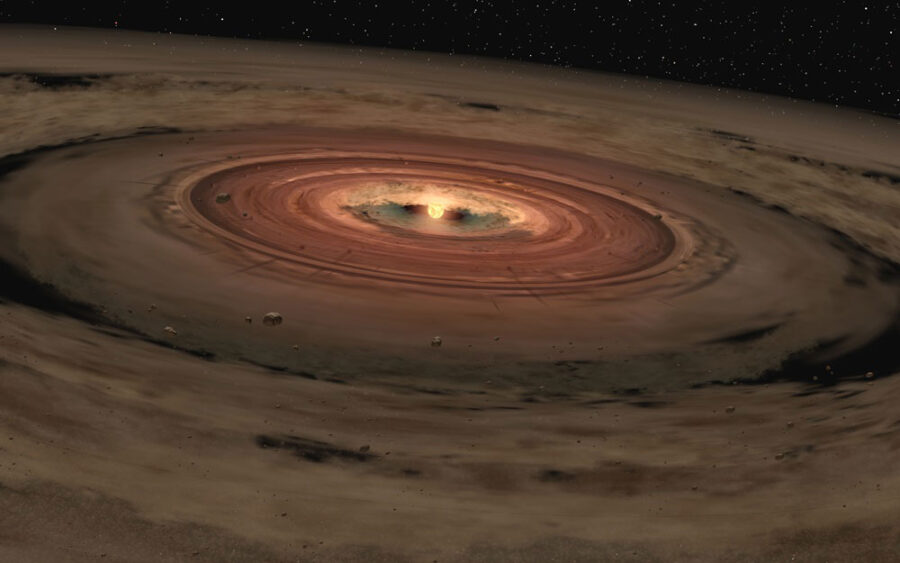New research shows stellar flybys are common in our galaxy’s crowded center.

ESO / NASA / JPL-Caltech / M. Kornmesser / R. Hurt
Close quarters are common in the center of the Milky Way, where stars are more tightly packed than they are farther out in the disk, where the Sun is. But just how much the jostling will affect planetary evolution remains an open question.
New research suggests that more than half of the bulge stars undergo a relatively close flyby — close enough to breeze the outskirts of what would be their solar system — as many as 35 times in a billion years, a frequency that could have a significant effect on how young worlds grow.
Close Encounters
While thousands of exoplanets have been spotted around other stars, very few have been identified in the heart of the galaxy. Part of that comes from the challenges of observing those crowded environs. The Sun orbits the galaxy more than 25,000 light-years from the center, and detecting an exoplanet farther away than 1,500 light-years can be tricky. Most of the exoplanets that have been spotted so far come from NASA's Kepler Space Telescope, which used the transit technique, looking for a planet passing between Earth and its sun multiple times during its orbit. But all of the worlds more than 10,000 light-years away were found by microlensing, a method that results from a rare one-time lineup of a planetary system and a background star.
As a result, astronomers aren't certain just how rare planets might be in the heart of the Milky Way. But in a new study graduate student Moiya McTier (Columbia University) has reported that the bulge might not be the best environment for growing worlds.
After simulating how bulge stars interact with each other over time, she found that roughly 80% of them have close encounters over a billion-year period. In fact, half the bulge stars will pass within 1,000 astronomical units (a.u.) of another star, brushing closer than the inner edge of the solar system's Oort cloud, not just once but dozens of times over the course of a billion years.
About a third of bulge stars have a visitor within 100 a.u., just outside the Kuiper Belt where Pluto and other dwarf planets live. A handful, less than 1 in 5,000, have company swing by within 10 a.u., just past the distance of Saturn.

NASA / JPL-Caltech
Getting Realistic
Planets form in the first tens of millions of years after their star is born, growing from the disk of leftover stellar material. Stars, on the other hand, are typically born in groups known as stellar clusters that move apart as the stars age. If stars are tightly packed in their nurseries, they can have an impact on planets before the worlds are born. But while a lot of studies had simulated close encounters in stellar nurseries, not nearly as many had probed the center of the galaxy.
"I couldn't help but wonder if we would find a different result in the galactic bulge, a part of the galaxy where stars are faster, closer, and moving on less predictable orbits," McTier says.
In addition, while previous work that examined the frequency of stellar flybys used idealized circular orbits, the new study relies on more realistic examples. The close press of stars can lead to some stars taking unusual paths around the galactic center, resulting in more flybys.
"Some bulge stars move on elliptical orbits, but some of them also move on box- or X-shaped orbits," McTier says. "Many of them move on rosette orbits that look like what you might draw with a spirograph."
While McTier's work didn't directly measure how strongly stellar visitors affect growing planets, the research provides a foundation for future studies. Previous research by other astronomers has already shown that nearby stars can have disastrous effects on their planets.
"It’s possible that close encounters could rip planets away from their host star, destabilize planet orbits so that they get flung from the system or crash into the star, or even interrupt the planet formation process," McTier says.
The new study was published in the Monthly Notices of the Royal Astronomical Society.
What This Means for Planets

NASA / JPL-Caltech
It’s not all bad news. According to Maxwell Cai (Leiden Observatory, The Netherlands), who was not involved in the study, intruder stars could help or hurt growing planets. The visitor’s tidal gravitational forces can cause small gravitational changes in the disk of dust and gas that will help material clump together into planets more easily. Alternately, an invading star could evaporate the gas and dust needed for planet formation, or even tear apart some or all of the disk.
Already-formed planets can also survive reasonably nearby encounters, as long as the gravitational forces aren't too strong, in other words if the star stays far enough away. "If the perturbation is mild, the young planet might be able to withstand it — at least for awhile," Cai says.
But a visitor within 1,000 a.u. could spell disaster for planets. The Oort Cloud is thought to surround the solar system, its small icy bodies cast off from the birth of the planets. These long-period comets can take thousands or even millions of years to orbit the Sun and most would never come near Earth. But a visiting star could send material hurtling inward towards newborn planets, even if a collision could take millions more years to occur.
The next step for McTier and her colleagues is to make their simulations more detailed in terms of the types of stars and regarding the stability of planet-forming disks. "Taking all of these into account will give us a much better understanding of the survival rate of planets in the Milky Way bulge," the team writes.
 0
0









Comments
You must be logged in to post a comment.